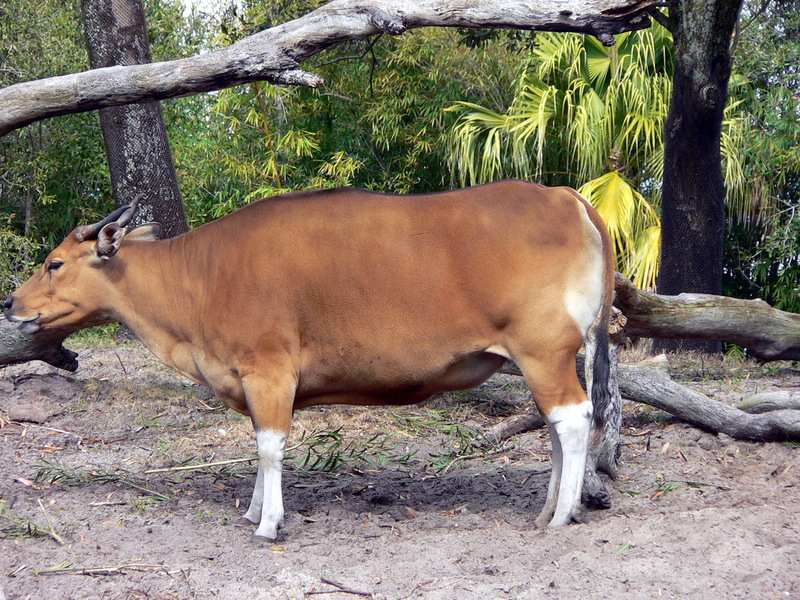|
| Query: banteng | Result: 1st of 34 | |
Banteng (Bos javanicus) - Wiki
| Subject: | Banteng (Bos javanicus) - Wiki
| |

| Resolution: 2016x1512
File Size: 1374890 Bytes
Date: 2006:01:20 13:01:04
Camera: DMC-FZ3 (Panasonic)
F number: f/2.8
Exposure: 10/2500 sec
Focal Length: 382/10
Upload Date: 2007:09:09 22:17:33
|
Banteng
From Wikipedia, the free encyclopedia
[Photo] Banteng (Bos javanicus) in Disney's Animal Kingdom. Taken by Raul654 in January, 2006.
The Banteng, Bos javanicus is an ox that is found in Myanmar, Thailand, Cambodia, Laos, Vietnam, Borneo, Java, and Bali. Some Banteng were introduced to Northern Australia during British colonization in 1849.
Physical characteristics
Banteng grow to about 1.6 metres at the shoulder and 2.3 m in head-body length. Banteng bulls usually weigh between 680 - 810 kg, females are smaller. Some very large males may weigh a ton. Banteng have white stockings on their lower legs, a white rump and white patches around their eyes and muzzle, however there is considerable sexual dimorphism. Males have a blue-black or dark chestnut coat, long upward arching horns and a hump over the shoulders. Females, however, have a reddish brown coat, small horns, which point inwards at the tips and no hump.
Distribution
As of February 2005, the Banteng population of the Cobourg Peninsula is 10,000 head, making the population in the Northern Territory the largest herd in the world. Before the study by Charles Darwin University it was believed that only 5,000 pure-strain Banteng survived worldwide. In their native range the largest herd numbers less than 500 head.
Behaviour
Banteng live in sparse forest where they feed on grasses, bamboo, fruit, leaves and young branches. The Banteng is generally active both at night and day time but in places where humans are common they adopt a nocturnal schedule. Banteng tend to gather in herds of two to thirty members.
Banteng have been domesticated in several places in Southeast Asia, and there are around 1.5 million domestic Banteng. Domestic and wild Banteng can mate and offspring are often fertile.
Subspecies
Java Banteng (B. j. javanicus): Java; Males are black, females buff.
Borneo Banteng (B. j. lowi): Borneo; Smaller then Java Banteng and the horns are steeper, bulls are chocolate-brown.
Burma Banteng (B. j. birmanicus): Burma, Thailand, Cambodia, Vietnam;
Burma Banteng (B. j. birmanicus): Burma, Thailand, Cambodia, Vietnam; Males and females are usually buff, but in Cambodia are 20 % of the bulls blackish, and on the Malayan Peninsula in Thailand are even most of the bulls black. These subspecies is classified as Critically Endangered by the IUCN.
Cloning
The Banteng is the second endangered species to be successfully cloned and the first to survive for more than a week (the first was a Gaur that died two days after being born). Scientists at Advanced Cell Technology in Worcester, MA, USA extracted DNA from Banteng cells kept in the San Diego Zoo's "Frozen Zoo" facility, and transferred it into eggs from domestic cattle, a process called somatic cell nuclear transfer. 30 embryos were created, sent to Trans Ova Genetics, which implanted the fertilized eggs in domestic cattle. Two were carried to term and delivered by caesarian section. The first was born on April 1, 2003, and the second two days later. The second was euthanized, but the first survived and, as of September 2006, remains in good health at the San Diego Zoo.
http://en.wikipedia.org/wiki/Banteng
| The text in this page is based on the copyrighted Wikipedia article shown in above URL. It is used under the GNU Free Documentation License. You may redistribute it, verbatim or modified, providing that you comply with the terms of the GFDL. |
|
Comments |
|---|
| | Guest |
|
Scientific Name: Bos javanicus d'Alton, 1823
Common Name(s): Banteng, Tembadau, tsaine
Synonyms:
Bos birmanicus Lydekker, 1898
Bos lowi Lydekker, 1912 |
| | Guest |
|
Scientific Name: Bos javanicus d'Alton, 1823
Common Names: Banteng, Tembadau, Tsaine, Bali Cattle
Synonyms:
Bos birmanicus Lydekker, 1898
Bos lowi Lydekker, 1912
Bos banteng Wagner, 1844 |
^o^
Animal Pictures Archive for smart phones
^o^
|
|
|

